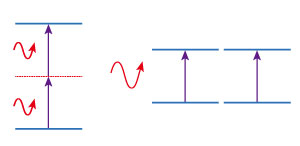Nov. 25, 2016 Research Highlight Physics / Astronomy
Single photon excites two atoms at once
Calculations reveal how one particle of light can excite two atoms simultaneously
 Figure 1: In two-photon absorption (left), two photons excite a single atom or molecule (left). Nori and co-workers have now shown that one photon can excite two or more atoms or molecules (right). © 2016 Franco Nori, RIKEN Center for Emergent Matter Science
Figure 1: In two-photon absorption (left), two photons excite a single atom or molecule (left). Nori and co-workers have now shown that one photon can excite two or more atoms or molecules (right). © 2016 Franco Nori, RIKEN Center for Emergent Matter Science
Our understanding of quantum optics has received a boost by the discovery, by RIKEN researchers, of a way to excite two atoms with only one light particle, or photon (Fig. 1)1.
Franco Nori from the RIKEN Center for Emergent Matter Science leads a team exploring how light confined in small mirrored cavities makes atoms behave strikingly differently from free atoms. In particular, the electromagnetic forces generated by the light in a cavity induce the atom’s electrons to oscillate with the same frequency as the confined light. By tuning this so-called resonant frequency, scientists can trap atoms in high-energy excited states useful for quantum computing devices.
Intrigued by the possibility of using this ultrastrong coupling between the electromagnetic field and the atom’s electrons to excite multiple atoms with a single photon, Nori and colleagues in Italy modeled two identical atoms in a cavity. To their surprise, the calculations predicted that if the cavity’s resonant frequency is exactly twice the atom’s transition frequency to a higher energy state, each atom can take half the photon’s energy and jump to the higher energy state. The same effect can occur with three atoms when the resonant frequency is triple the atomic transition frequency.
Furthermore, the researchers discovered that the entire process should be reversible—multiple excited atoms in the cavity can relax by releasing a single photon.
Nori notes that the mechanism behind this process derives from the peculiar properties of light in a vacuum. “In effect, the system temporarily ‘borrows’ a second photon from the cavity,” he explains. “These ‘virtual’ photons are generated from chance fluctuations in the cavity’s vacuum. They appear and disappear all the time.”
The virtual photon helps the two-atom–one-photon system reach a new quantum state that combines two situations—one where both atoms are in their ground states with a photon in the cavity and another where the two atoms are excited and no photon is present. “Eventually, the system emerges from this blend of two states into purely the excited one,” Nori adds.
The researchers anticipate that this predicted phenomenon might be realized experimentally with superconducting ‘artificial atoms’ that have precisely engineered energy levels. “This process might lead to useful spectroscopic and diagnostic tools, but the details will take time,” says Nori. Furthermore, excitation of two atoms by a single photon could produce quantum states in which more than two particles are entangled, which would be useful for quantum cryptography and computation.
References
- 1. Garziano, L., Macrì, V., Stassi, R., Di Stefano, O., Nori, F. & Savasta, S. One photon can simultaneously excite two or more atoms. Physical Review Letters 117, 043601 (2016). doi: 10.1103/PhysRevLett.117.043601
